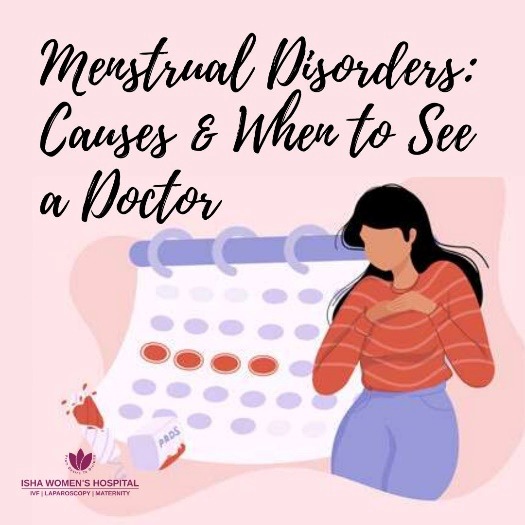Menstrual Disorders: Causes & When to See a Doctor

Understanding your menstrual health is the first step toward managing any issues effectively. In this blog, we’ll explore the common types of menstrual disorders, their causes, and when you should consider seeing a doctor.
Understanding Menstrual Disorders
What Are Menstrual Disorders?
A normal menstrual cycle usually lasts between 21 to 35 days, and the bleeding typically lasts for 2 to 7 days. Some women may have lighter flow, while others may bleed more heavily — both can be normal as long as the pattern is regular and not causing discomfort or health issues.
However, if your periods suddenly change or have always been difficult to manage, it could be a sign of a menstrual disorder. You should be concerned if:
- Your periods are too heavy (soaking through pads/tampons quickly)
- They last too long (more than 7 days)
- They come too often or with long gaps in between
- Your cycles are very irregular or completely stop
- You experience severe pain or cramping that interferes with daily activities
Menstrual disorders are common and can be caused by hormonal imbalances, stress, weight changes, medical conditions like PCOS or thyroid disorders, or even certain medications.
The good news is that most menstrual disorders can be diagnosed and treated with the right care. If you notice any unusual changes in your cycle, it’s important to speak to a gynecologist. Early diagnosis and treatment can help you feel better and prevent future complications.
Common Types of Menstrual Disorders
- Amenorrhea is characterized by the absence of menstrual periods for three or more months. This condition can be caused by pregnancy, stress, low body weight, or polycystic ovary syndrome (PCOS).
- Dysmenorrhea refers to severe menstrual cramps, which may result from conditions like endometriosis, fibroids, or hormonal imbalances.
- Menorrhagia involves excessively heavy or prolonged menstrual bleeding and is often linked to fibroids, blood clotting disorders, or hormonal issues.
- Oligomenorrhea is marked by infrequent menstrual periods and can be due to PCOS, thyroid disorders, or extreme weight loss.
- Polymenorrhea describes very frequent periods, which may be caused by a short luteal phase or hormonal imbalances.
- Premenstrual Syndrome (PMS) includes symptoms such as mood swings, bloating, and headaches, typically triggered by hormonal fluctuations before menstruation.
What Causes Menstrual Disorders?
1. Hormonal Imbalances
Changes in hormone levels can be caused by:
- Stress
- Polycystic Ovary Syndrome (PCOS)
- Perimenopause (transition to menopause)
- Thyroid problems
- Irregular or missed periods
- Heavy bleeding
- Mood swings
- Fatigue
PCOS is a common hormonal condition that affects how the ovaries work. Women with PCOS often have high levels of androgens (male hormones), which can prevent ovulation (release of eggs).
Common symptoms of PCOS include:
- Irregular or missed periods
- Acne and oily skin
- Weight gain or difficulty losing weight
- Excess facial or body hair
- Difficulty getting pregnant (infertility)
In endometriosis, the tissue similar to the lining inside your uterus starts growing outside of it. This can lead to severe pain and heavy periods.
Signs of endometriosis:
- Intense menstrual cramps
- Heavy bleeding
- Pain during sex
- Lower back pain or pelvic pain
Fibroids are non-cancerous growths in the uterus. Many women have them without symptoms, but when they grow larger, they can affect their periods.
Symptoms include:
- Heavy or long-lasting periods
- Pelvic pressure or pain
- Frequent need to urinate
- Backache
The thyroid gland controls your metabolism and also affects your menstrual cycle.
- Hypothyroidism (low thyroid function) can cause heavy and prolonged periods.
- Hyperthyroidism (overactive thyroid) can lead to light or infrequent periods.
Solutions for Menstrual Disorders
Natural Ways to Regulate Menstrual Cycles
What you eat plays a big role in keeping your hormones in balance. A healthy, nutritious diet helps regulate your periods and boosts overall reproductive health.
- Iron-rich foods (like spinach, lentils, and red meat) help make up for blood loss during periods.
- Omega-3 fatty acids (found in fish, flaxseeds, and walnuts) reduce inflammation and support hormone balance.
- Vitamin B6 (found in bananas, potatoes, and chickpeas) can help with mood swings and hormonal regulation.
2. Exercise & Healthy Weight Management
Maintaining a healthy weight is very important for regular periods. Being overweight can lead to excess estrogen, which may cause heavy or irregular periods. Being underweight can result in missed or delayed periods due to low hormone levels.
Simple daily activities like walking, yoga, or dancing can make a big difference. Try to get at least 30 minutes of moderate exercise most days of the week.
3. Stress Reduction Techniques
Stress is one of the hidden reasons behind hormonal imbalance. High stress levels can delay your periods or even stop them altogether.
- Practice yoga or meditation regularly.
- Get 7-8 hours of good sleep every night.
- Take breaks, spend time in nature, or do things that make you feel happy and relaxed.
Medical Treatments for Menstrual Disorders
Medical Treatments for Menstrual Disorders
1. Hormonal Birth Control
Hormonal birth control (like pills, patches, or hormonal IUDs) is commonly used to treat menstrual disorders.
It helps by:
- Regulating your cycle
- Reducing heavy bleeding
- Easing painful cramps
2. Medications for Specific Disorders
For PCOS:
- Metformin helps improve insulin resistance and can help regulate periods.
- Hormonal therapy can reduce high androgen levels, control acne and unwanted hair growth, and restore regular ovulation.
- Pain relievers like NSAIDs can help manage severe cramps.
- Hormone therapy may slow the growth of endometrial tissue and ease pain.
3. Surgery for Severe Cases
Sometimes, when medications don’t work or the condition is advanced, surgery may be needed.
- Myomectomy is a procedure to remove fibroids from the uterus while preserving fertility.
- Endometriosis excision surgery is done to remove abnormal tissue growing outside the uterus, helping relieve pain and improve fertility.
When to See a Doctor for Menstrual Problems
- You’ve missed your periods for 3 months or more (and you’re not pregnant)
- Your bleeding lasts longer than 7 days or is very heavy (soaking through pads or tampons quickly)
- You have severe cramps or pain that affect your work, sleep, or daily activities
- Your periods are irregular and come with other issues like unexplained weight gain, acne, or hair thinning
Menstrual disorders are more common than many women realize — and the good news is that they are very manageable with the right care and attention. Whether it’s irregular periods, heavy bleeding, or painful cramps, understanding your body is the first step toward finding relief.
Keeping track of your menstrual cycle — including when your period starts, how long it lasts, how heavy it is, and any unusual symptoms — can help you spot changes early and share accurate information with your doctor.
Remember, if your symptoms are affecting your daily life or not improving with lifestyle changes, don’t hesitate to seek medical help. With the expert guidance of Dr Chinmay Pataki at Isha Women's Hospital, you can take control of your menstrual health and feel your best.
Frequently Asked Questions (FAQs)
Ans - If your cycle is consistently shorter than 21 days or longer than 35 days, heavy, or painful, it may be abnormal.
2. Can stress cause menstrual disorders?
Ans - Yes! Chronic stress raises cortisol, affecting ovulation & cycle length.
3. How can I regulate my periods naturally?
Ans - Eat a balanced diet, manage stress, exercise, and maintain a healthy weight.
4. Can birth control help with menstrual disorders?
Ans - Yes! Hormonal birth control regulates cycles and reduces symptoms.
5. When should I worry about irregular periods?
Ans - You should worry about irregular periods if they are frequent, persist for several months, are accompanied by severe pain or heavy bleeding, or affect your overall health and well-being.
